
By Kerry Norman, senior vice president of people and operations
My daughter is a recent graduate working her first job, but I’m sad to say we had to address the topic of equal opportunity and gender parity in compensation. It’s a shame that it’s still a topic of conversation — both for our family and for the nation. After all these years, many employers still haven’t gotten it right.
Wage bias is rarely intentional
For most of my career, I’ve been the only woman, or one of a handful of women, in executive meetings. It’s made me reflect on the lack of representation — not only by women but by all under-represented groups. If we don’t have a seat at the table, we can’t be part of the executive decision-making, which includes compensation discussions.
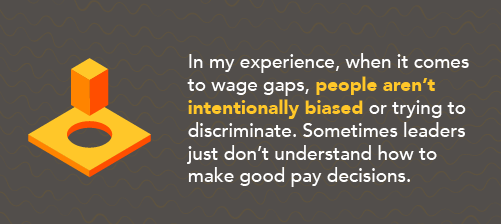
In my experience, when it comes to wage gaps, people aren’t intentionally biased or trying to discriminate. Sometimes leaders just don’t understand how to make good pay decisions. Sometimes employees, or potential employees, don’t know how pay works or how decisions around it are made. When you have a lack of education on both sides, leader and employee, it can lead to assumptions and gaps.
What is equal pay… really?
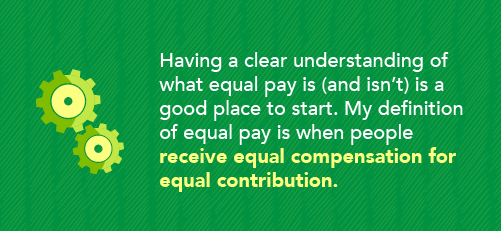
Having a clear understanding of what equal pay is (and isn’t) is a good place to start. My definition of equal pay is when people receive equal compensation for equal contributions.
Compensation plans should also include ways to recognize and honor performance. At the same time, it’s important to understand that two employees with the same job title may vary widely in their experience, expertise, and contributions. Individual compensation should reflect those differences.

It starts with commitment
At CHG Healthcare, I’m proud to say our numbers are much better. Our data would tell you there is no pay difference based on gender. Here are what our numbers look like at CHG:
- On average, women at CHG make 100% compared to men
- 63% of our workforce identify as female
- 54% of our leaders are women
- 34% of our female employees are in VP roles and above
- 46% of our directors and above identify as female
Recognizing differences
Women often face life challenges that are less common for their male counterparts. For example, many women choose what some call “pink collar” jobs, such as teaching and caregiving. These jobs often pay less than other career choices. This can set up a “start low/stay low” compensation dynamic some women never overcome. It’s also more common for women to leave the workforce for a period than for men. These employment gaps are often related to caregiving for family members.
CHG has built its benefits package around some of those unique needs. We offer fully paid maternity and medical leave. Plus, all employees have access to Wellthy, a care-advocacy network that provides support and resources for employees dealing with aging family members and elderly care, veteran support, special needs, and other health conditions.
Making course corrections
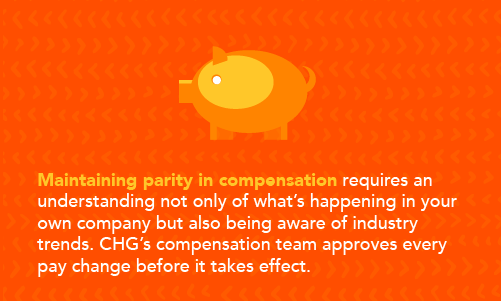
Maintaining parity in compensation requires an understanding not only of what’s happening in your own company but also being aware of industry trends. CHG’s compensation team approves every pay change before it takes effect. That gives the company an opportunity to audit compensation in real-time. These audits have helped us identify some important factors that can affect pay equity.
For example, we learned that women at CHG tend to have more tenure than men and grow with our organization throughout their careers. Our male employees, on the other hand, have often advanced in their careers by changing companies. Generally speaking, those who move from organization to organization often have more leverage and can grow their compensation more quickly than those who stay many years with one company. As a result, our goal has been to ensure that women who have advanced internally at CHG remain equally positioned with their male counterparts who are hired from outside.
Another learning involved our digital and engineering roles. We found we were hiring people at higher wages than people who had been with us longer. Both scenarios required a compensation course correction that acknowledged the value of experienced team members.
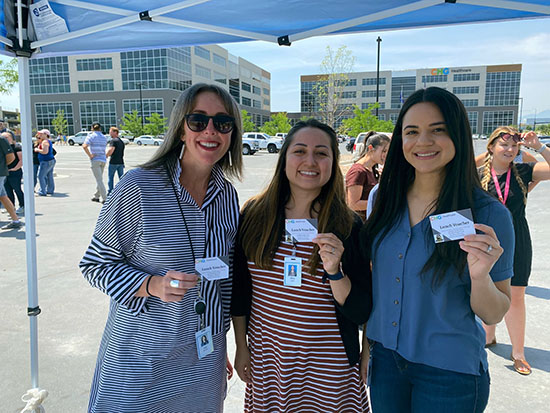
A solid compensation structure
A commitment to pay equity can’t come solely from the talent acquisition team or human resources. The executive team at CHG Healthcare understands that pay equity is not only the right thing to do; it’s also important for business success. Our executive team has been very intentional about building a company and a culture where equal compensation is a standard business practice.
For CHG, a solid compensation structure starts with talent recruiters. I often remind recruiters not to ask a job candidate what their previous salary was. Those conversations may tempt a recruiter to go lower with an offer. The right question is really, what is this job worth? A candidate may have been undervalued in their previous position. We don’t want to continue that trend.
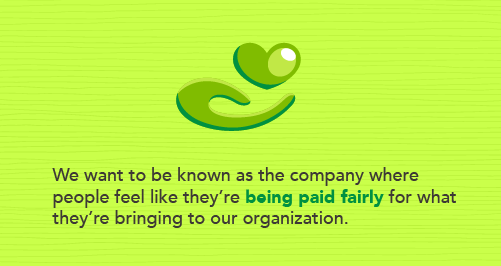
Underpaying someone is a short-sighted view. We want to be known as a company where people feel like they’re being paid fairly for what they’re bringing to our organization. So, we are open with job candidates, telling them upfront what the salary range is and letting the candidate decide whether or not that works for them.
Sometimes pay adjustments are necessary to ensure parity between men and women or between new and tenured employees. Whenever this occurs, we have a commitment from the top down to do the right thing, even if that means adjusting department budgets to ensure compensation equity.
Leader education
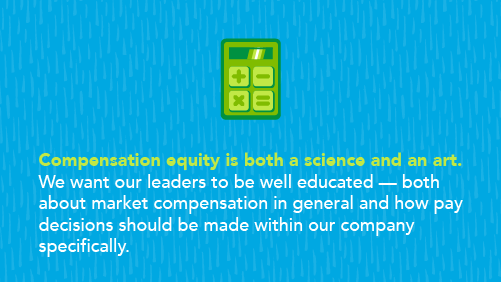
Compensation equity is both a science and an art. We want our leaders to be well educated — both about market compensation in general and how pay decisions should be made within our company specifically.
Our compensation team trains leaders at least annually, answering questions about wages and employees’ total rewards package. The team is also available any time leaders have questions. The goal is to help leaders appropriately recognize their team members through compensation that helps them feel recognized and rewarded. Leaders need to be able to understand and explain how an individual is growing financially for their good work.
Equally as important, leaders need to understand each team member’s “why.” Knowing why an employee chooses a job — as well as what they hope to gain from it besides a salary — is key to keeping an employee engaged and happy.
Employees should be proactive
All of us want to grow in our careers and financial growth is an important part of that. Employees who are worried or wondering about how their own pay compares should do their own research. Websites like Salary.com can give you average pay rates for different jobs — but it’s important to factor in your skills, experience, and expertise when you estimate what you should be earning.
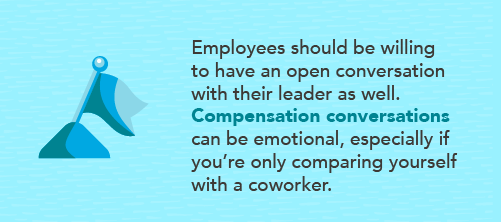
Employees should be willing to have an open conversation with their leader as well. Compensation conversations can be emotional, especially if you’re only comparing yourself with a coworker. It’s important to remember this is a business discussion. Opening the conversation with something like, “I’d like to better understand our pay philosophy. Given it’s been a hot employment market, do you feel my compensation is where it should be?” It’s also helpful to offer specific examples of how you have contributed to the team and the company.
When talking to my daughter about compensation, I said the same thing to her that I would share with women everywhere. Know that you can contribute. Negotiate effectively by doing your research. Be willing to advocate for yourself. Then help every other woman in your sphere do the same. Excellence, opportunity, and equality belong to all of us.
Interested in working for a company that is committed to pay equity for all its employees? Check out our open positions.